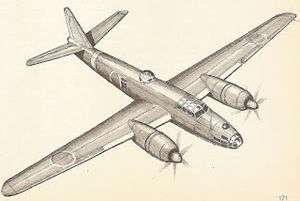Mitsubishi Q2M
| Q2M | |
|---|---|
 | |
| Role | Anti-Submarine Patrol aircraft |
| National origin | Japan |
| Manufacturer | Mitsubishi |
| Developed from | Mitsubishi Ki-67 |
The Mitsubishi Q2M "Taiyō" design was derived from the Mitsubishi Ki-67-I Hiryū ("Peggy") heavy/torpedo bomber of the Japanese Army (and "Yasukuni" Navy's torpedo bomber version). It was ordered for design and construction in the last stages of war.
Development
Powerful engines of 1,380 kW (1,850 hp) would have been used to drive five-blade propellers. Such an aircraft would have been managed by five or six crew. Due to technical troubles and a long development of the theoretical design, this aircraft did not advance from paper plans in last days of conflict.
Specification (Q2M)
General characteristics
- Crew: 6
- Length: 18.75 m (61 ft 6 in)
- Wingspan: 25 m (82 ft 0 in)
- Height: 4.75 m (15 ft 7 in)
- Empty weight: 8,850 kg (19,511 lb)
- Gross weight: 13,600 kg (29,983 lb)
- Powerplant: 2 × Mitsubishi Kasei 25 Otsu 14-cylinder air-cooled radial piston engines, 1,030 kW (1,380 hp) each
Performance
- Maximum speed: 490 km/h (304 mph; 265 kn)
- Range: 2,415 km (1,501 mi; 1,304 nmi)
- Service ceiling: 3,704 m (12,152 ft)
Armament
- Guns: 3 × 13 mm (0.51 in) machine guns
- Bombs: 4 × 250 kg (550 lb)
Avionics
- Type 3 Model 1 Magnetic Anomaly Detector (KMX)
- Type 3 Ku-6 Model 4 Radar
- ESM Antenna equipment
References
Notes
Sources
This article is issued from
Wikipedia.
The text is licensed under Creative Commons - Attribution - Sharealike.
Additional terms may apply for the media files.